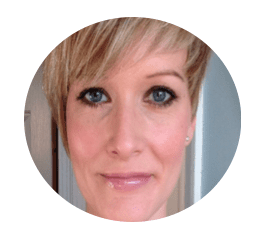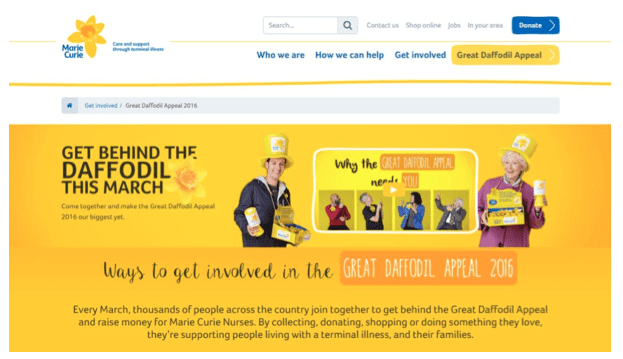Luke Bilton, Director of Digital at UBM, interviews Claire Hazle of Marie Curie
Claire Hazle, Head of Digital for Marie Curie, is taking the charity through a period of transformation… just don’t call it ‘digital’.
“Digital transformation is business transformation. A business strategy with digital at the heart of it.”
Claire Hazle, Head of Digital at Marie Curie
Speaking at a Digital Transformation conference earlier this month, Claire explained the transformation journey that the team have been through.

In 2012, Marie Curie commissioned a review of their digital capabilities and found they were 3 to 5 years behind charities of a similar size, with talent dispersed across the group with no strategic digital direction to bind them.
The independent report highlighted the charity would face significant limitations to future income if they did not improve the digital channels to make it easy to recruit and retain supporters. This helped prove the need for investment into the board of trustees, and a business case was approved for a three and a half year transformation project.
Website relaunch
One of the initial changes was the website itself.
“The website was previously organised around our business, but it needed to be organised around the customer’s needs. We used to have a separate mobile site and everything was hard-coded making it hard to make updates.
“We launched a new responsive website which gives a more consistent experience across devices and simplified navigation. The design is modular, so it gives our team more flexibility in changing messaging.”

The new Marie Curie website
The relaunched site has significantly improved the conversion funnel with a 25% uplift in donation conversion. Users are spending 24% more time on the site and improved ecommerce functionality has helped to drive a 9% growth in income from the website’s shop.
“Online is now the single biggest trading channel (which has overtaken post and phone), and nearly half of customers are now making a donation as part of purchase journey.”
Digitising the Great Daffodil Appeal
The advantages of digital go far beyond a website. This can be seen through the way Marie Curie has transformed its Great Daffodil appeal, the charity’s flagship annual appeal.
“The Great Daffodil appeal involves recruiting a small army of 25,000 volunteers each year to help raise £8m. In 2013 the process was very manual, with local teams around the country handling lots of spreadsheets and phone calls. It was very inefficient, with 30% of those who expressed interest not being contacted to go onto a shift.”
In 2015, the Great Daffodil Appeal was handled very differently, with the website and marketing automation bringing in a number of benefits. These included:
- Self-service portal for volunteers meant that they were able to load up their own shifts, so administering shifts improved;
- Emails featured dynamic content which were sent out with geo-locational information such as the weather forecast in their postcode area;
- Volunteers were encouraged to tell their own story through video, helping to create social proof to inspire others;
- Triggered SMS wished collectors good luck on the morning of their collection and shared the total amount raised;
- Gamification was used to ‘upsell’ volunteers into signing up for more than one collection – this created ‘super collectors’ which increased average collections per head;
- Automation was used to trigger workflows that were based on lead times.
Embedding digital into the fabric of the organisation
To deliver this, Claire built a centralised team of 20 people, with five others embedded into other teams. However, over the next few years the priority is to start to embed knowledge of digital throughout the organisation.
“My priority is now on building up one-to-one relationships. We have an influencer strategy having identified people in other teams we can involve in the mission, with a steering group of eight champions across the organisation.
“It’s really important that the champions come from functions such as finance and HR and not just marketing. We meet monthly to review and prioritise change requests for the website together as a group.”

Is digital still the odd one out?
Claire feels that the label ‘digital transformation’ itself has become unhelpful and closed the programme a year early.
“Digital transformation makes you look different, suggesting people are off in a cupboard doing something techie. Marie Curie closed the transformation programme a year early because having a separate board and packs was starting to hold us back.
“It’s completely relevant to the whole company, so integrating it into the fabric of our organisation is the right way forward for us at the moment. We will get further with it being part of business as usual than being a separate team”
Transformation Tips
Claire gives her top tips for a successful transformation programme:
- Ground everything in evidence. Spend where you’ll make the biggest difference, whether this be a large or small budget.
- Take people with you on the journey and be aware of the organisation’s pulse. As charities are driven by direct mail, digital transformation and automation can be scary. You must build relationships and remember, don’t leave people behind.
- Build solid foundations but keep people interested when it’s not sexy.
- Test and learn as you go. Be flexible and prepare to change your pace/direction if needed. E.g. having to rewrite the business case, if the landscape changed or changed direction.
- Be realistic and don’t get distracted by shiny new toys. It’s easy to feel guilty by not leveraging all the new technologies. “Our supporters have an average age of 60yrs, so some are never going to be online.”
- Define benefits as clearly as you can upfront. If you can’t, at least define the hypothesis. This can be hard if the data you benchmark against is a mess, but you can start with the hypothesis.
Claire Hazle will be speaking at Technology for Marketing 28-29th September at London, Olympia. Register for your free ticket here










